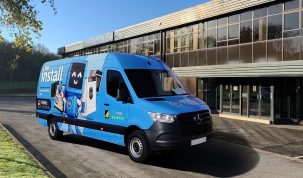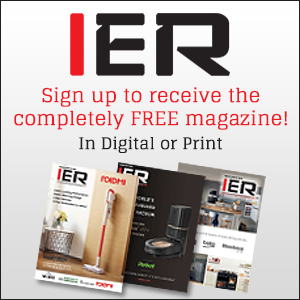
An espresso maker is now regarded as an essential addition to the modern kitchen. It’s time to approach coffee makers as a serious sales opportunity – especially ahead of the Christmas season, advises Anna Ryland.
Coffee drinking has become part of the daily ritual in this country. A recent survey by Philips showed that the average Brit has two cups of coffee at home and another two while working and travelling. The survey also revealed that 51% of the population prefer coffee over tea as their favourite drink.
“The past decade has seen a phenomenal rise in the UK café culture as foreign travel has increased and the continental trend for cafés has spread throughout the country,” says Joan Fraser, Smeg product and training manger.
“With the staggering growth in the past few years of coffee shops like Café Nero, Costa Coffee and, of course, Starbucks, we are more aware of coffee quality. Many of us eat out regularly and often end a good meal with a cup of coffee,” comments Allan Blackman, Bosch category manager, consumer product division. Then he adds: “We are increasingly keen to recreate coffee-shop/restaurant coffee in our own homes, and the general trend towards a better cup of coffee in the home means that in many households, coffee makers are no longer luxury items.”
The recessionary climate has stimulated sales of coffee makers: “In the current climate people are going out far less and instead are investing more money into their properties. Sales in the coffee machine market are experiencing steady growth because people are increasingly including built-in coffee machines in their kitchen planning. For those who have little built-in space there is always the possibility for a freestanding coffee machine,” says Claire Ratnam, junior product manager at Miele.
Simon Bara, product marketing manager at Whirlpool confirms this: “With a great many people choosing to upgrade their existing homes instead of moving house, and entertaining at home being a strong focus, the kitchen and its appliances have become a big priority.”
Capitalising on this trend, a number of leading DA brands have recently entered this market launching both freestanding and built-in models.
The fast growing market
“The sales value of hot beverage makers reached close to £4 million in August 2011, a 23% increase on August 2010. The sales value of espresso machines is fast approaching three quarters of overall value of the market, having increased by 30% between August 2010 and August 2011. This growth was triggered by the average selling price of espresso machines rising from £136 in August 2010 to £147 in August 2011,” explains Helen Warner, GfK analyst.
“Filter coffee machines still have the highest volume share of the market, but it declined from 56% in August 2010 to 51% in August 2011, with espresso machine sales taking their place. For espresso machines, internet sales value has increased from a quarter of the market to over a third.
Perfecting the drink
“In recent years, coffee machines have developed rapidly in terms of technology. Many top end machines are now fully automatic and offer the option of personalisation according to the tastes of the user. However, the most critical element is the power of the pump. 15 bar pressure is the optimum requirement so the customer can recreate the perfect coffee within the comfort of their own home,” says Smeg’s Joan Fraser.
It’s worth remembering that there are four main types of coffee makers that produce differently tasting drinks.
The most traditional are filter coffee machines that are easiest to use. Hot water drips slowly through a basket of ground coffee to infuse in a pot or carafe. Filter coffee machines usually have hot plates to keep the coffee warm and use permanent or paper filters.
In percolators, ground coffee is put into a holder at the top, water in the bottom. Once boiled, the water is forced up a vertical tube and through the filter, with the brewed coffee settling in the bottom of the jug.
Coffee from espresso machines is more concentrated and is the base of a cappuccino or latte. There are two basic types of machines, with pump machines being more expensive. In pressure machines water is boiled in a chamber and this builds pressure and steam. Eventually enough pressure is built up and forces the boiling water through to the coffee. The steam can be used for frothing.
Espresso pump machines have a separate tank and a thermostatically-controlled boiler with a ‘Thermoblock’ system that heats up the water to between 85-92°C – the optimum temperature for making coffee. The water is then sent through the coffee holder at the correct bar pressure. Some machines also use a pod system.
Nespresso is a ‘pod’ system that produces espresso coffee. The coffee is blended, roasted, grounded, and then hermetically sealed in capsules. The advantages of this system are its simplicity and consistently perfect result. The downside is that the user is tied to the supplier’s range of coffees.
Built-in coffee machines range from bean-to-cup models and pod systems to fully automated models with options personalising the characteristics of users’ favourite drinks.
Most customers considering a purchase of a coffee machine want them to be easy to use while producing ‘authentic’ results. They expect it to: “give them the perfect tasting coffee in a warm cup; be able to produce no-fuss rich, creamy frothy milk without any user intervention, is equipped with effortless controls, is simple to maintain and creates a statement in the kitchen,” says Miele’s Claire Ratnam.
Also since cappuccino and latte are the two most popular types of coffee in the UK “the steam arm is an important feature,” reminds David Rogers, home sales & marketing director, Lavazza UK.
In the case of built-in models the issue of installation – whether plumbing is available or not – is also an important consideration, reminds Whirlpool’s Simona Bara.
What’s on offer?
Krups offers an assortment of products that meet various needs; “whether consumers are looking for convenience through a pod system, or want an authentic tasting espresso by grinding their own coffee beans,” says Chetana Raj, product manager at Groupe SEB. The new Nescafe Dolce Gusto by Krups Piccolo and the Nescafe Dolce Gusto by Krups Creativa are the latest additions to the Dolce Gusto Family. The Dolce Gusto system allows users to make a variety of drinks using the different flavoured pods. Krups Nespresso produces an espresso coffee with a pod, while Krups Compact Espresseria is a compact bean to cup machine.
Bosch has added a black version to its popular range of Tassimo multi-drinks machines. New from Siemens are the EQ7 and EQ5 and a number of built-in models for Bosch, Siemens and Gaggenau. The EQ7 bean-to-cup machine with 19 bar pre
ssure is equipped with a special Senso-Flow heating element that ensures the water is kept at an ideal temperature for 30 seconds during the brewing process, offering the fastest first cup in this class of machines.
The fully-automatic machines – the EQ5 Macchiato and EQ5 Macchiato Plus have many features, including adjustable coffee strength and double-shot setting; grind-setting, nozzle-height and drink-size adjustment. The Macchiato Plus offers an extra one touch setting for perfect latte or cappuccino style.
AEG has just launched a new espresso machine, A Modo Mio Favola, in collaboration with the Italian coffee producer, Lavazza. Based on Lavazza’s capsule system, the machine delivers the taste of real Italian espresso with perfect crema at the touch of a button. The machine will be supported by a £1 million seasonal promotion.
Miele is launching in November an updated version of the freestanding CM5100 Barista. The new CM5200 will enable the consumer to make two cups of coffee at the touch of a button using the new automatic milk heating and frothing feature. Miele’s integrated models offer the choice of either a bean-to-cup system or the Nespresso capsule system.
Smeg built-in coffee machines offer bean to cup operation and they are designed to fit into a 45cm high niche. They take either beans or ground coffee and offer a choice of five levels of programmable coffee strength, as well a hot water function for tea and other hot drinks.
Whirlpool’s latest integrated machines deliver an automatic ‘bean to cup’ experience at the correct pump pressure to develop a crema on the top. They have an auto-start mode and the user’s personal settings can be stored so they can have their perfectly brewed cup of coffee every time. Importantly, the brewing unit is removable for easy cleaning.
The aesthetics
“Design still plays a key role in choosing a coffee machine, as it is usually on display. Price is important and very competitive at entry level, but less so with more expensive machines. Consumers are still willing to pay for quality, design and features,” explains Bosch’s Allan Blackman.
Most of the latest models have a contemporary clean and stylish look, with stainless steel and ‘soft’ black being the main finishes, although bright, ’neon’ colours, such as these used on Nespresso Pixie or AEG/Lavazza Modo Mio Favola, are increasing finding favour with consumers.
“There is a growing trend for more compact and user friendly machines. The latest offering from AEG and Lavazza is smaller, very easy to use and complies with the latest legislation around energy efficient domestic appliances,” says Lavazza’s David Rogers.
The proof of the pudding
There are plenty of facts to suggest that the coffee maker has become a ‘must have’ kitchen appliance. It should be remembered, however, that the price is not the only factor which holds consumers back from making this investment. Many of them don’t know the options available to them, how difficult it is to operate the appliance and clean it. Your product knowledge and advice should help them to make the right choice for their needs.
“We would always recommend having appliances wired up and ‘live’ in the showroom. This is especially true of the coffee centre as it doubles up as a welcome opening introduction to the showroom. If you ask a potential customer if they would like a coffee before you talk them through the appliances, it sets the scene in a relaxed atmosphere straightaway. It is also a good time for the retailer to familiarise themselves with the appliance as it provides an opportunity of demonstrating how quick and easy it is to use,” suggests Mike Jarrett, Neff sales director.
Sales tips
• Ask your customer what sort of coffee they like: filter, espresso or cappuccino; how they like it made, how often they plan to use their machine and how much involved they wish to be in the process.
• Product knowledge is essential. Explain the fundamental difference between product options available.
• Demonstration is key. Show the customer the main features and how easily they could create their favourite drink. Show them that cleaning the appliance is not a problem.
• Learn about varieties of coffee and their characteristics (see www.talkaboutcoffee.com). This will make your sales pitch more credible.
• Make a cup of coffee for your customer; let them enjoy the taste and the aroma waffling around, while you continue the selling process.











